Technical Notes - e1
NLM Classification, 5th Edition Additions and Changes List 4 - e2
PubMed: Searching Using Subsets - e3
![]() OLDMEDLINE Database Moves Back in Time - e4
OLDMEDLINE Database Moves Back in Time - e4
MEDLINEplus - e6
OLDMEDLINE Database Moves Back in Time
OLDMEDLINE was first made available in December 1996 with over 307,000 citations originally published in the 1964 and 1965 Cumulated Index Medicus (CIM) (see NLM Technical Bulletin, 1996 Nov-Dec; (293): 1, 4-6). Prior to December 1996, pre-1966 data was not searchable electronically. The OLDMEDLINE database was created in response to user requests and will continue to expand to meet the demand for electronic access to information from these earlier years. In completion of the next phase of NLM's goal to provide online access to citations published in Index Medicus before 1966, over 400,000 citations published in the 1960 through 1963 CIM were added to OLDMEDLINE in November 1998. The file now contains 771,287 citations.
OLDMEDLINE is available free to searchers on the Web via Internet Grateful Med (http://igm.nlm.nih.gov) [This link was removed because it is no longer valid.] as well as to ELHILL command language searchers at regular billed rates. To access OLDMEDLINE via ELHILL, enter the command: FILE OLDMEDLINE, or FILE OLDMED, at any USER: prompt. The focus of this article, however, is on using Internet Grateful Med (IGM) to search OLDMEDLINE at no cost.
Introduction
While the data is easy to search, OLDMEDLINE records have been entered into the database using standards that are different from the data entry standards for current MEDLINE records. There are also variations among OLDMEDLINE citations in the data elements (fields) present in the citation as well as in their format, depending on the original source from which the citation was obtained. These variations in the data elements have consequences for document delivery which are discussed below. The differences in the data present in OLDMEDLINE citations are described in the paragraphs that follow, and two sample OLDMEDLINE records are shown in
Figure 4 and Figure 5.
Document Delivery
Loansome Doc, a document ordering feature of PubMed and Internet Grateful Med, is unable to accept document orders from OLDMEDLINE. This is because the majority of citations in OLDMEDLINE do not have the Journal Title Code (JC) which is necessary to process an interlibrary loan electronically through the Loansome Doc automated request routing system. The full text of the journal article can be obtained through interlibrary loan from a local library. Because the National Library of Medicine does not loan or copy materials directly to individuals, please contact a local library for its interlibrary loan services and fees. Detailed information on interlibrary loans from within the U.S. and outside the U. S. can be found at
https://www.nlm.nih.gov.
Note to participating DOCLINE libraries: OLDMEDLINE citations for the years 1964-1965 will route on the SERLINE routing table. Citations for the years 1960-1963 will route on the monograph routing table.
Data Quality
The 1964 and 1965 CIM data were converted from data tapes provided by the Deutsches Institut fur Medizinische Dokumentation und Information (DIMDI), the International MEDLARS Center in Germany, with minimal data cleanup and validation. NLM was able to provide limited data validation for this data based on the Journal Title Codes (JC) that are present in the citation data. These JCs were matched to SERLINE records to provide current Title Abbreviation (TA), ISSN (IS), and Country (CY) data in the old OLDMEDLINE citations. However, the 1960 through 1963 citations keyed from the printed indexes do not include JC information, and, therefore, were not matched against current SERLINE information for TA, IS, or CY data.
Citations in OLDMEDLINE lack the individual and accumulated changes and improvements that have been made to data in other ELHILL files during annual file maintenance. Certain fields may contain outdated or erroneous data. For example, the multiple parts of a compound surname in the AUTHOR field may appear as one name, e.g.,
- AU - ESCALONAZAPATA J
- Actual name in article: J. Escalona Zapata
All alphabetic characters in citations from the 1964 and 1965 CIM appear in upper case in all fields. For citations from the 1960 through 1963 CIM, only the authors are shown all in upper case. The other information is displayed using both upper and lower case characters. More information about the formats for the Title (TI) and the Keyword (KW) fields is given below.
Date of Publication
The Date of Publication information has been machine-manipulated to follow the current MEDLINE format of 4-digit year, abbreviated month, and, if provided, day. This information is displayed in IGM as part of the Source.
Title (TI)
All alphabetic characters in titles from citations in the 1964 and 1965 CIM are in upper case. In the 1960 through 1963 CIM, the first letter of the first word of each "sentence" in the title as well as a proper nouns and acronyms (following standard English language usage) are capitalized. For example, note the capitalization in the following 1962 title: Epidemiologic studies on hypertension and coronary heart disease in a Japanese rural population. I. A study of blood pressure in Chiyoda.
Transliterated/Vernacular Title (TT)
Non-English language titles appear only on citations from the 1964 and 1965 CIM. These vernacular title words are not included in a Text Word search.
Year (YR)
The year is directly searchable in Internet Grateful Med. Scroll down to the Apply Limits section at the bottom of the Search Screen and select the desired year. The default is All years as shown in Figure 1.
Please note that each volume of CIM contains some citations from the previous one to two calendar years. So, if you select ALL as the option for the year, your search may include citations from 1959 or 1958, because the 1960 CIM contained these records.
Figure 1 - Selecting a Year Limit in OLDMEDLINE in IGM
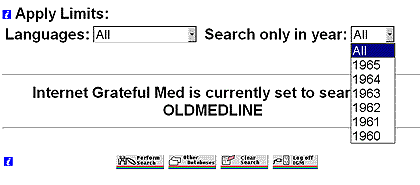
Abstracts
The citations in OLDMEDLINE do not have abstracts.
Subject Retrieval: Keywords (KW) and Text Words (TW)
The original Medical Subject Headings (MeSH) assigned to the citations have not been updated, and may not match current MeSH vocabulary. There are no subheadings in citations published in the 1963 through 1965 CIM. Citations from the 1960 through 1962 CIM do contain MeSH Heading/subheading combinations. MeSH Heading/subheading combinations are displayed in the 1960-1962 citations, but the subheadings are NOT searchable in this database. If you enter the word or words of a subheading on a subject line (e.g., etiology or adverse effects), the computer will retrieve the words as Text Words from the Title field only. Keywords are always displayed in upper case; subheadings, when present, are displayed in lower case.
To distinguish these older MeSH Headings from current MeSH in other ELHILL files, all MeSH terms have been placed in the Keyword (KW) field. There are no data in the MeSH Heading (MH) field. As a result, the MeSH terms in OLDMEDLINE do not relate to current MeSH Tree numbers, and the NLM ELHILL "explode" and "pre-explode" capabilities are not functional for this file. The NLM plans to map old MeSH Headings and MeSH Headings/subheading combinations now in the Keyword (KW) field to current MeSH in the future.
When you search by subject, IGM automatically looks for your single-word term or multi-word term in both the Keyword field and as single words in the Text Word field. A multiple word MeSH term is searched by ANDING together the individual words as Text Words, as well as looking for the term/phrase in the Keyword field. For example, if you enter the term "diabetes mellitus" on the IGM subject line, as shown in Figure 2 and run your search and then click on the Details of Search button, you will see the terms that are actually searched as displayed in Figure 3.
Figure 2 - Searching a Multi-word MeSH Heading in OLDMEDLINE in IGM
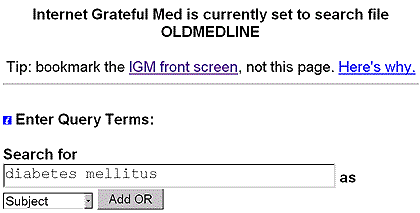
Figure 3 - Details of Search Display for Diabetes Mellitus
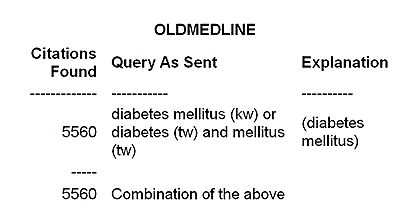
Two sample citations from the search on diabetes mellitus are shown in Figures 4 and 5. These citations were chosen to illustrate the differences that will display in the records in this file. Both citations shown are not in English, but only the citation in Figure 4 (1965) shows a vernacular title because only citations from 1964 and 1965 have the Transliterated /Vernacular (TT) field. Only the citation in Figure 5 (1962) displays subheadings because only citations from 1960-1962 contained subheadings in the record.
Figure 4 - 1965 OLDMEDLINE Citation
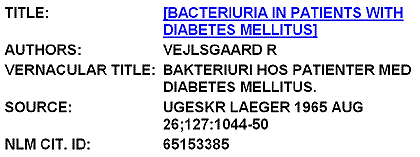
Figure 5 - 1962 OLDMEDLINE Citation
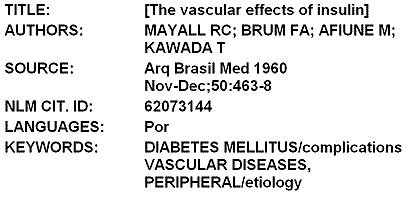
Only the MeSH Heading (MH) portion of the MH/sh combination is searchable in the Keyword field. If you enter "diabetes mellitus etiology" on an IGM subject line, the IGM search engine will look for all three words together as a single Keyword and for each of them individually as Text Words ANDed together. Because the complete MeSH heading/subheading combination is NOT present in the Keyword field (only the MH has been put into the searchable Keyword field) your search will retrieve only on diabetes (TW) AND mellitus (TW) AND etiology (TW).
Remember, a Text Word search in OLDMEDLINE retrieves words from only the Title and Keyword fields (there are no abstracts in this database). So a search on "diabetes mellitus etiology" will retrieve 23 citations but it will NOT retrieve the citation shown in Figure 6 because this citation contains the word etiology only in the subheading field, not in the Title or Keyword field. For this reason, and because subheadings are not on all citations, searching specifically for subheadings is not recommended in OLDMEDLINE. You may search on words that appear in subheadings in your search, just be aware that your retrieval will be based on these words appearing in the Title or MeSH Heading portion of the MH/sh displayed in the Keyword field.
Figure 6 - Citation NOT Retrieved with Search on: diabetes mellitus etiology
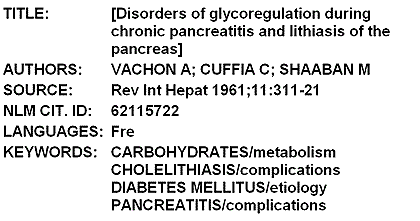
Additional Search Tips
Please note that although the display of various fields may be all upper or lower case or some combination of the two, searching is not affected by the case you use when entering your search terms.
When searching, keep in mind the absence of abstracts in OLDMEDLINE, and the fact that fewer MeSH Headings were assigned per article (approximately 6 per citation). Both of these conditions affect subject retrieval.
None of the terms assigned to OLDMEDLINE citations are flagged as the major topic of the article. If you try to restrict your search to major topic, you'll get no retrieval. However, because fewer MeSH Headings were assigned, they are each more likely to indicate a major concept in the article.
You may truncate a search term by using a colon, e.g., diabet: will retrieve citations with diabetes or diabetic in the Keyword and Title fields.
Important to remember: There are no MeSH heading check tags such as HUMAN or ANIMAL present in this database. So don't use check tags in your search strategy, because they are not likely to help you get relevant retrieval.
Updating Frequency and File Maintenance
NLM expects to continue converting citations from its older medical indexes to machine readable form and to add these citations as time and resources permit. Typographical errors, or erroneous or outdated data cannot be corrected at this time.
- --prepared by Susan Von Braunsberg and Toby Port
- MEDLARS Management Section
